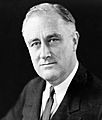Social liberalism facts for kids
Social liberalism is a political idea that believes the government should help make society fair for everyone. It's a bit different from older ideas of Liberalism because it thinks the state has a role in solving big problems like unemployment or making sure everyone has health care and a good education.
For example, in Britain, before the late 1800s, the government didn't really support general education for everyone. Help for poor people often came from private groups or churches. Social liberalism changed this thinking, suggesting that the government should step in to help people and create a more equal society.
This idea led to things like public services (like schools and hospitals) being available to everyone, not just those who could afford them. It also helped expand Democracy by giving more people the right to vote. Social liberalism believes that when the community does well, individuals are also more free. Many countries, especially after World War II, have used social liberal ideas to shape their policies.
Contents
What is Social Liberalism?
Social liberalism is a way of thinking about how a government should work. It's a type of liberalism that focuses on making sure everyone has a fair chance in life. This means the government might create programs to help people, like providing good schools or making sure everyone can see a doctor.
How is it Different from Other Ideas?
Social liberalism is often compared to classical liberalism. Classical liberalism usually believes the government should have a very small role in people's lives and the economy. It focuses more on individual freedom and less on government help.
Social liberalism, however, thinks the government should get involved to fix problems in society and the economy. It believes that true freedom means people have the support they need to succeed, not just the absence of government rules.
Key Ideas of Social Liberalism
Social liberalism has several important beliefs that guide its policies. These ideas aim to create a society where everyone has opportunities and is treated fairly.
Fairness and Equality
A main goal of social liberalism is to make sure wealth and power are shared more fairly. This doesn't mean everyone gets the exact same amount, but it means reducing big differences between the very rich and the very poor. Over time, this led to support for things like public services that benefit everyone, such as libraries, parks, and public transportation.
Expanding Rights and Freedoms
Social liberalism also believes the government should work to expand civil rights. This means making sure all people, no matter who they are, have the same basic rights and freedoms. It supports the idea that the "good of the community" and the "freedom of the individual" can work together. When society is strong and fair, individuals can thrive.
Government's Role in Society
Social liberals believe the government has a responsibility to help its citizens. This includes:
- Providing education for all children.
- Making sure everyone has access to health care.
- Helping people who are unemployed or struggling.
- Creating a safety net so people don't fall into extreme poverty.
These ideas became very popular in many parts of the world, especially after World War II, when countries were rebuilding and looking for ways to create more stable and fair societies.
Important Thinkers and Policies
Many people have helped shape the ideas of social liberalism. Their work has influenced governments and policies around the globe.
John Rawls and Social Justice
In 1971, a philosopher named John Rawls wrote a famous book called "A Theory of Justice". He talked about "new liberalism" and how it focuses on creating a theory of social justice. This means thinking deeply about how to share resources, ensure equality, and make things fair in society and politics. His ideas are sometimes debated, especially by those who support neoliberalism, which often favors less government involvement.
Historical Examples
- David Lloyd George was a British politician who strongly supported social liberal ideas in the early 1900s. He helped bring in new laws that provided benefits to sick and unemployed workers.
- In the United States, Franklin D. Roosevelt's "New Deal" policies in the 1930s were a big example of social liberalism in action. These programs aimed to help people during the Great Depression and reshape the role of government in the economy.
Where Social Liberalism Stands Today
Social liberal ideas and the political parties that support them are usually seen as centrist or centre-left. This means they are often in the middle of the political spectrum or slightly to the left. They try to balance individual freedom with the need for social fairness and government support.
Images for kids
-
Leonard Hobhouse, who wrote important books about social liberalism.
-
Thomas Hill Green, another key thinker in social liberalism.
-
Franklin D. Roosevelt, a US President whose "New Deal" policies were very social liberal.
-
David Lloyd George, a British Prime Minister who expanded social welfare programs.
See also
 In Spanish: Socioliberalismo para niños
In Spanish: Socioliberalismo para niños








